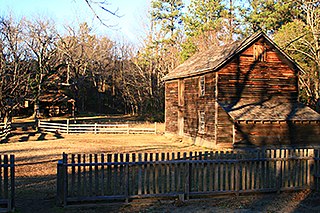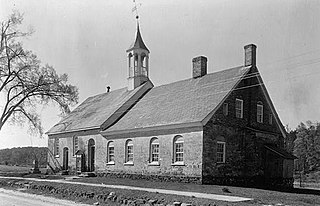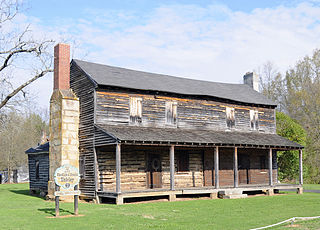
Creedmoor is a city in Granville County, North Carolina, United States. The population was 4,124 at the 2010 census.

Mebane is a city located mostly in Alamance County, North Carolina, United States, and partly in Orange County. The town was named for Alexander Mebane, an American Revolutionary War general and member of the U.S. Congress. It was incorporated as "Mebanesville" in 1881, and in 1883 the name was changed to "Mebane". It was incorporated as a city in 1987. The population as of the 2020 census was 17,797.

James Buchanan Duke was an American tobacco and electric power industrialist best known for the invention of modern cigarette manufacture and marketing techniques, and his involvement with Duke University. He was the founder of the American Tobacco Company in 1890.

Horne Creek Farm is a historical farm near Pinnacle, Surry County, North Carolina. The farm is a North Carolina State Historic Site that belongs to the North Carolina Department of Natural and Cultural Resources, and it is operated to depict farm life in the northwest Piedmont area c. 1900. The historic site includes the late 19th century Hauser Farmhouse, which has been furnished to reflect the 1900-1910 era, along with other supporting structures. The farm raised animal breeds that were common in the early 20th century. The site also includes the Southern Heritage Apple Orchard, which preserves about 800 trees of about 400 heritage apple varieties. A visitor center includes exhibits, a gift shop and offices.

Richard Joshua Reynolds was an American businessman and founder of the R. J. Reynolds Tobacco Company.
Arcadia is an unincorporated community in Davidson County, North Carolina, United States. It is located in the northwestern section of the county along NC Highway 150. Neighboring communities and municipalities include Midway, Welcome and Winston-Salem.

Duke Homestead State Historic Site is a state historic site and National Historic Landmark in Durham, North Carolina. The site belongs to the North Carolina Department of Natural and Cultural resources and commemorates the place where Washington Duke founded the nation's largest early-20th-century tobacco firm, the American Tobacco Company.

Bethabara Historic District encompasses the surviving buildings and archaeological remains of a small Moravian community, that was first settled in 1753. Located in present-day Forsyth County, North Carolina, it is now a public park of the city of Winston-Salem. It was designated National Historic Landmark in 1999.

The Reynolds Building is a 314-foot (96 m) Art Deco skyscraper at 51 East 4th Street in Winston-Salem, North Carolina. It was completed in 1929 and has 21 floors with 313,996 square feet (29,171.2 m2) of space. For much of its history the building served as headquarters for R. J. Reynolds Tobacco Company. After a sale to PMC Property Group in 2014, the building went through an estimated $60 million in renovations. In March 2016, The Residences @ the R.J. Reynolds Building, apartments located on the top 11 floors, opened. The first six floors opened as the Kimpton Cardinal Hotel in April. Katharine Brasserie & Bar, a restaurant named for Katharine Smith Reynolds, followed in May.
The Cannady–Brogden Farm is a historic home and farm located near Creedmoor, Wake County, North Carolina. Built in 1904, the house is an example of a Queen Anne style, triple-A-roofed, I-shaped building. In addition to the house, other structures on the farm include: a corn crib, a woodshed, a washhouse, a covered well, a chicken coop, a smokehouse, a stackhouse, a packhouse, a machinery shed, a mule barn, a cow shed, and a tobacco barn.
The Heartsfield–Perry Farm is a historic home and farm located at Rolesville, Wake County, North Carolina, a satellite town of the state capital Raleigh. The original one-room house was built in the 1790s, with a Greek Revival style update made about 1840. It is a two-story house with two-story rear ell and one-story rear shed addition. It features a double-tier Greek-Revival-style—porch and low hipped roof. The interior of the house retains some Federal style design elements. Also on the property are the contributing detached kitchen, smokehouse / woodshed, privy, doctor's office, mule barn, pack house, horse barn, feed barn, two tobacco barns, the family cemetery, and the agricultural landscape.

The Obediah Shirley House, sometimes referred to as the Obediah and Jennie Shirley Home is a historic farmhouse with a fieldstone foundation, located near Honea Path, South Carolina. Its construction was completed in several phases in order to accommodate the Shirley family as their family grew in number. The original, one-story log cabin was built in 1826 with the second-floor and two rooms to the north added before 1850. After 1850, a third room was added to the house, which increased the width. The front porch and kitchen were added in later in the 19th century.
Hampton–Ellis Farm, also known as William Beanis Hampton Farm and Jonah Ellis Farm, is a historic home and tobacco farm located near Bahama, Durham County, North Carolina. The farmhouse was built about 1900, as a one-story, three-bay, center hall plan dwelling. It was enlarged about 1922, with the addition of a kitchen ell. The house features a one-story, hip-roofed front porch. Contributing outbuildings include the wood shed, cannery, smokehouse, feed house, tenant house, tenant smokehouse, tenant woodshed, pack house, ordering/stripping house, and four tobacco barns. With the exception of the ordering/stripping house and three of the tobacco barns, all the outbuildings were built about 1922.

Graylyn Estate, or Graylin, is a historic estate located in Winston-Salem, Forsyth County, North Carolina. It was listed on the National Register of Historic Places in 1978. The construction of the Norman Revival style mansion began in 1928. Associated with the house are a number of contributing outbuildings including a garage-guest house and "farm" complex. Today, Graylyn estate is used as a conference center and hotel. It is currently a member of Historic Hotels of America, the official program of the National Trust for Historic Preservation.

W. F. Smith and Sons Leaf House and Brown Brothers Company Building, also known as Piedmont Leaf Tobacco Co., is a historic tobacco manufacturing complex located at Winston-Salem, Forsyth County, North Carolina. The complex includes two buildings. The W. F. Smith and Sons Leaf House was built about 1890, and is a 4+1⁄2-story, nine bays long and three bays wide, stuccoed brick building with a stepped gable facade. The former Brown Brothers building, was built between 1890 and 1895, and is a five-story brick building with a mansard roof and hip roof dormer windows. By 1900 both buildings housed tobacco prizeries.

Winston-Salem Tobacco Historic District is a national historic district located at Winston-Salem, Forsyth County, North Carolina. The district encompasses 16 contributing buildings and 16 contributing structures in a predominantly industrial section of Winston-Salem. The buildings date from about 1890 to 1959, and include buildings relating to the tobacco industry, specifically R. J. Reynolds Tobacco Company. Also on the district are a once-thriving African American and the wholesale commercial business district that once catered to the R. J. Reynolds Tobacco Company workers. Located in the district is the separately listed Romanesque Revival style S. J. Nissen Building and Piedmont Leaf Tobacco Company.
John Henry Royster Farm is a historic tobacco farm complex and national historic district located near Bullock, Granville County, North Carolina. The farmhouse was built about 1860, and is a two-story, heavy timber frame dwelling. It features Greek Revival and Gothic Revival style design elements patterned after regional architect Jacob W. Holt. Also on the property are the contributing garage, corn crib, shed, dairy, smokehouse, chicken house, brooder house, a square notched log striphouse, two-square-notched log tobacco barns, a metal-sheathed log tobacco barn and a frame packhouse.
Obediah Farrar House is a historic home located near Haywood, Lee County, North Carolina. It was built in the 1850s, and is a two-story, three-bay, mortise-and-tenon frame I-house with Greek Revival style design elements. Also on the property is the contributing road segment and landscape.
Dupree–Moore Farm, also known as the Thomas Dupree House, is a historic home and tobacco farm located near Falkland, Pitt County, North Carolina. The house was built between about 1800 and 1825, as a 1+1⁄2-story, three-bay, frame dwelling. It was enlarged to two stories and rear additions added and remodeled in the Greek Revival style about 1848. A two-story rear "T" addition was added about 1861. The house features a one-story full-width shed-roof front porch with Picturesque-style latticework. Also on the property are the contributing smokehouse, tobacco grading house, pump house/utility shed, frame equipment shelter, mule barn, tobacco packhouse, tenant house, tenant tobacco packhouse, sweet potato house, log tobacco barn, tobacco barn, and tobacco packhouse.
Obediah is a name and may refer to:















